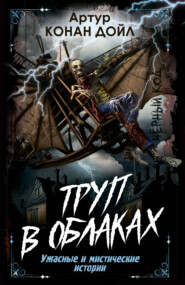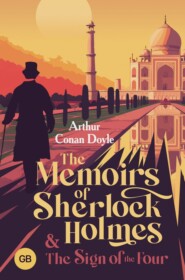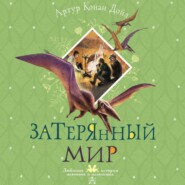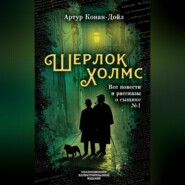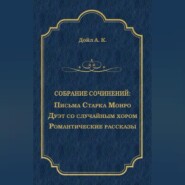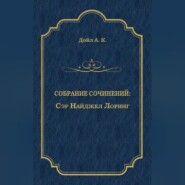По всем вопросам обращайтесь на: info@litportal.ru
(©) 2003-2024.
✖
Arthur Conan Doyle: A Life in Letters
Настройки чтения
Размер шрифта
Высота строк
Поля
You must remember her sweet face, her sensitive mouth, her peering, short-sighted eyes, her general suggestion of a plump little hen, who is still on the alert about her chickens.
But you cannot realise all that she is to me in our domestic life. Those helpful fingers! That sympathetic brain! Ever since I can remember her she has been the quaintest mixture of the housewife and the woman of letters, with the high-bred spirited lady as a basis for either character. Always a lady, whether bargaining with the butcher, or breaking in a skittish charwoman, or stirring the porridge, which I can see her doing with the porridge-stick in one hand, and the other holding her Revue des Deux Mondes within two inches of her dear nose. That was always her favourite reading, and I can never think of her without the association of its browny-yellow cover.
She is a very well-read woman is the mother; she keeps up to date in French literature as well as in English, and can talk by the hour about the Goncourts, and Flaubert, and Gautier. Yet she is always hard at work; and how she imbibes all her knowledge is a mystery. She reads when she knits, she reads when she scrubs, she even reads when she feeds her babies. We have a little joke against her, that at an interesting passage she deposited a spoonful of rusk and milk into my little sister’s ear-hole, the child having turned her head at the critical instant. Her hands are worn with work, and yet where is the idle woman who has read as much?
Even at the peak of his fame, Conan Doyle solicited his mother’s advice on nearly every aspect of his life and career—and even when he did not, she often provided it anyway—including, in one famous example, persuading him to refrain from killing off Sherlock Holmes. (She not only pleaded successfully for the detective’s life, but also gave her son the plot device for a new story. ‘He still lives,’ Conan Doyle told her at the end of the first set of the stories, ‘thanks to your entreaties.’) But not all her advice was literary; she also counselled him on his tortuous love for the young woman who would become his second wife, while his first wife was still struggling against tuberculosis. While he did not preserve many of her letters to him, he did save the ones in which she strove vehemently to dissuade him from volunteering for the Boer War in 1899. In those letters her will and intellect shine every bit as forcefully as those of her famous son.
In addition, there were several more women in Conan Doyle’s life whom he regarded as ‘second mothers’, addressing them, as he did his own, by the honorific ‘Mam’. They did not exert the same developmental influence upon him as his own mother did, but he clearly regarded them with an esteem that went beyond simple family friendship. There was Mrs Charlotte Drummond, a close family friend in Edinburgh with whose two children Conan Doyle had grown up. His letters to her are in the Sherlock Holmes Collections of the University of Minnesota Library. Another was Mrs Amy Hoare, the wife of a Birmingham doctor, Reginald Ratcliff Hoare, under whom Conan Doyle worked a number of times as both a medical student and a fledgling doctor. Both Hoares became second parents to him, and his letters to them are in the Henry W. and Albert A. Berg Collection of English and American Literature at the New York Public Library. Finally, there was Mrs Margaret Ryan, of Edinburgh, the mother of the one lifelong friend he made at school, James Ryan. Some of his letters to her are among his papers now at the British Library.
CONAN DOYLE’S FAMILY
Conan Doyle was part of a very large family, and it is no simple matter to keep all of its members straight as the reader moves through his letters.* (#ulink_2738a29d-1208-5fe4-86e4-fdf0a1268b4c) His grandfather John Doyle, the London political cartoonist known as ‘H.B.’, was born in April 1797, and died on January 2, 1868, when Conan Doyle was eight years old. He had some memory of his grandfather, but not of his paternal grandmother, Marianne Conan, who had died at the end of 1839. Her brother, Michael Conan, a journalist who lived in Paris much of his life, was godfather to Arthur and his older sister Annette, with his surname being added to theirs at the baptismal font to form the compound name Conan Doyle. This name was not held by their parents’ subsequent children.
John Doyle himself had seven children of whom five survived past adolescence. James Doyle (1822-92), Richard Doyle (1824-83), and Henry Doyle (1827-92) have been mentioned previously, along with Arthur’s father, Charles Altamont Doyle, who was born on March 25, 1832, and died on October 10, 1893. In addition, there was a daughter, Ann Martha Doyle (1821-99), called Annette, who played an important part in her nephew’s life. With the exceptions of Arthur’s father, who went to Edinburgh when young, and his uncle Henry, who spent many years in Dublin, the family’s life centred in London.
On his mother’s side, Arthur Conan Doyle’s other grandfather was William Foley (1807-40) of Lismore, County Waterford, Ireland. He married Catherine Pack in 1835. She died in 1862, and seeing her lifeless body was Arthur’s earliest memory. William and Catherine Foley had two daughters: Conan Doyle’s aunt Kate, Catherine Foley, born in 1839 (but who emigrated when he was young, and the date of her death is unknown); and Conan Doyle’s mother, Mary Josephine Elizabeth Foley, who was born in Lismore on July 8, 1837, and died at her home ‘Bowshott Cottage’ in West Grinstead, Surrey, on December 30, 1920.
Charles Doyle and Mary Foley married on July 31, 1855, and lost little time in starting their large family. Two daughters died young: Catherine Amelia Angela, who lived only six months in 1858, and Mary Helena Monica Harriet, who was born in 1861 but died after two years. Five other daughters and two sons survived to adulthood, with names frequently drawn from relatives or friends, with the occasional saint’s name for good measure:
ANNE MARY FRANCES CONAN DOYLE, born on July 22, 1856, and known as Annette (‘Tottie’ when young) after her aunt and namesake. Called ‘the prop of the family’ by Arthur for her hard work helping to raise and educate her younger brothers and sisters, she never married, and she died from influenza at the age of thirty-three, on January 13, 1890.
ARTHUR IGNATIUS CONAN DOYLE, born on May 22, 1859, and died on July 7, 1930, at age seventy-one. His first marriage, in 1885, to Louisa Hawkins (nicknamed ‘Touie’), produced two children, Mary and Kingsley; his second marriage, in 1907 to Jean Elizabeth Leckie, produced three children, Denis, Adrian (often called Malcolm in his youth), and Jean.
CAROLINE MARY BURTON DOYLE, called ‘Lottie’, was Arthur’s favourite sister. Six years younger than Arthur, she was born February 22, 1866. Lottie married Leslie Oldham in 1900, and they had one daughter, Claire. Lottie survived Arthur, dying on May 3, 1941.
CONSTANCE AMELIA MONICA DOYLE, the beauty of the family, called ‘Connie’, was born March 4, 1868, making her eight years younger than Arthur. She married the writer E. W. Hornung in 1893, and they had one child, Arthur Oscar. She died on June 24, 1924.
JOHN FRANCIS INNES HAY DOYLE, called Innes (or Frank, Geoff, then ‘Duff’, when young), was born March 31, 1873. Arthur took an active role bringing up his fourteen years’ younger brother. Innes married Clara Schwensen in 1911, and they had two sons, John and Francis, before his death on February 19, 1919.
JANE ADELAIDE ROSE DOYLE, called ‘Ida’, was born March 16, 1875, and died on July 1, 1937. In 1895 she married a widowed cousin, Nelson Foley, and they had two sons of their own, Percy and Innes.
BRYAN MARY JULIA JOSEPHINE DOYLE, called ‘Dodo’, was born March 2, 1877, and died on February 8, 1927, predeceasing her considerably older brother Arthur. She married the Reverend Cyril Angell in 1899, and they had one son, Branford.
CONAN DOYLE’S TIMES
Whether playing cricket with James Barrie, the author of Peter Pan, and Anthony Hope, the author of The Prisoner of Zenda, or golfing in a Vermont field with Rudyard Kipling, or writing plays for the leading actors of his day, or dining with William Waldorf Astor, or Winston Churchill, or Theodore Roosevelt, or the Prince of Wales, it can seem as if Conan Doyle was always at the centre of the great literary and political circles of his era. But this exalted life only came after many years of poverty and hard work, struggling first to make a success of himself as a physician, and then as a writer. His letters provide a rich and compelling chronicle of those times, from such commonplace matters as food parcels from home (‘the duck was in perfect condition after eight days’ travel’) through glamorous poetic descriptions of exotic foreign lands:
I ascended the pyramid this evening and saw the sunset. On one side the green delta of the Nile, still shining with scattered pools from the subsiding rivers, the minarets of Cairo in the distance, many scattered mud-coloured villages, lines of camels slouching from one to the other—on the other side the huge grey plain & rolling hillochs of the Sahara which extends straight from here to the Atlantic, 3000 miles.
His letters deal with a range of subjects that defined the age, including the literary and theatre worlds of both Britain and America, the British struggle for empire in Egypt and the Sudan; his country’s bitterly controversial war in South Africa; bitterly contested politics at home (including his own two campaigns for a seat in the House of Commons); the sunnier world of sports (including the early days of the Olympic Games); the perennial and unsolvable question of Ireland; divorce law reform and women’s suffrage (he was in favour of the first, and against the second); warnings about Germany’s intentions in the days before World War I and reports from the front after the war broke out; the coming of automobiles, motorcycles, airplanes, submarines, radio, and motion pictures; and many insights into famous contemporaries.
The result is both an intimate memoir and a window opening onto a bygone age. In these letters, especially the ones to his mother, Conan Doyle held few things back, from the lofty ambitions of youth—‘We’ll aim high, old lady, and consider the success of a lifetime, rather than the difference of a fifty pound note in an annual screw’—through the critical disappointments of his struggle to free himself from the public’s demand for more and more Sherlock Holmes, and his restless search for ‘some big purpose’ that would define his life and career.
SHERLOCK HOLMES, AND OTHER WORK
As one might expect, these letters hold many revelations about the origins of Sherlock Holmes. Not only does the young author give a vivid account of the great detective’s fitful beginnings, but it is intriguing to note many details from Conan Doyle’s private life that transferred into the stories. The letters from the 1880s spent in Southsea, a suburb of Portsmouth on the Channel coast, where the first two Holmes novels were written, offer vivid details of Conan Doyle’s early struggles as an aspiring author. He writes frequently of his difficulties in making ends meet, his problems with tax collectors, and trying to get by selling anonymous stories to the popular magazines of the day. As he makes his first tentative steps into the literary arena, he offers blunt assessments of each new manuscript (‘I have completed a very ghastly Animal Magnetic vampirey sort of a tale’), and details the apparently endless round of rejections that his early work amassed: ‘My dear, I am continually sending things to the Cornhill and they send them back with a perseverance worthy of a better cause.’
The eventual success of Sherlock Holmes (‘Sherlock Holmes seems to have caught on,’ he told his mother in 1891, in one of the great under-statements in literary history), and Conan Doyle’s notorious ambivalence toward his most famous creation, formed a thread throughout his life. The first two Sherlock Holmes novels in 1887 and 1889 were failures, but as the short stories burst onto the pages of the Strand magazine in 1891, Conan Doyle welcomed the sudden rush of wealth and fame. But very soon he became wary of being too closely associated with what he called the ‘humbler plane’ of detective fiction. ‘He takes me from better things,’ he told his mother.
The ‘better things’ included the historical novels he loved so much, after having been raised on the works of Sir Walter Scott. His first breakthrough came with a historical novel called Micah Clarke in 1889, and in 1891 his tale of the Middle Ages, The White Company, helped to convince him that he could give up medicine for writing. In books like these he believed that he was writing enduring literature, and he expected to achieve critical success—particularly with his 1906 novel Sir Nigel, a prequel to The White Company, the two of which, taken together, he believed formed a new and lasting contribution to the national saga.
Yet most critics saw them as merely tales of adventure, and not as entertaining as Sherlock Holmes, or as the picaresque Brigadier Gerard stories about the Napoleonic wars, or as Professor Challenger in pioneering science-fiction tales like The Lost World. It chafed Conan Doyle greatly, but in fact he had been true to a sentiment that he had expressed in an 1894 interview: ‘We talk so much about art that we tend to forget what this art was ever invented for. It was to amuse mankind—to help the sick and the dull and the weary. If Scott and Dickens have done this for millions, they have done well by their art.’
EDITING CONAN DOYLE’S LETTERS
Conan Doyle, like Dr Watson, had a tendency to be careless with dates. Of the many hundreds of letters written to his mother over more than fifty years, only a handful were dated. It was a daunting, at times maddening, task to determine the chronology of the letters based on stationery, return addresses (when present), and internal evidence. ‘The novel goes well,’ he often wrote, but which novel? ‘I have written a fine story’, but which story? ‘Many thanks for the birthday wishes’, but which birthday? Sherlock Holmes himself might have found it a three-pipe problem, and we would not be surprised to find the occasional letter out of place.
Conan Doyle was also careless with spelling and punctuation, a boyhood habit that persisted to some degree his entire life. Except where important for purposes of clarity, we have let spelling and punctuation errors stand as they appear in his letters.
Whenever possible Conan Doyle has been allowed to speak for himself. Many important things in his life occurred outside the compass of these letters. For the most part, the interconnective narrative we have provided tries not to stray from the spirit and content of what Conan Doyle himself chose to convey in his letters, in order to reflect as far as possible the weight and emphasis he gave the matters that he chose to report. But readers should keep in mind that his actual interests and activities and associations were even broader and more numerous than the many referred to here.
Conan Doyle lived at home with his family while attending Edinburgh University in the late 1870s and early 1880s, and therefore had no occasion to write letters describing, among many other striking features of a medical student’s life, his remarkable instructor Dr Joseph Bell, who helped inspire the character of Sherlock Holmes. In this instance, and in others, the void has been filled with other accounts from Conan Doyle’s own pen, so as to extend the fabric of personal narrative wherever possible.
Some liberties have been taken in editing the letters for publication. Shirley Nicholson points out in her book A Victorian Household (Stroud, UK: Sutton, 1994) that Victorians were constantly concerned for, indeed vocal about, their health. Conan Doyle, though living an active, robust, in fact athletic life, was no exception. From boyhood he claimed to suffer from neuralgia, and his letters constantly report head colds and sore throats. We have left intact enough variations on ‘I have a cold’ and ‘I have one of my throats’ to give the idea, but have stricken many more for fear of exhausting the reader’s patience. Similarly, Conan Doyle often conveyed tedious financial information to his mother in his letters, with scrupulous attention to the status and outlook of their investments. We have let many such references stand, but only the most single-minded reader would wish for all of them.
Finally, these letters do not solve all the mysteries about Conan Doyle’s life. It seems evident that the eight-year-old boy was not sent away to school in order to protect him from a drunken father—but Charles Doyle still remains a misty figure about whom scholars would wish to know more. The letters provide more information about the turbulent influence of Dr Bryan Charles Waller, who became part of the household in Edinburgh for a time in the 1870s—but nowhere near as much as students of Conan Doyle’s life would wish. And while Conan Doyle’s investigation of psychic phenomena and spiritualism began when he was a struggling doctor in Southsea in the early 1880s, he told his apparently unsympathetic mother next to nothing about it until 1916, when he finally embraced Spiritualism to fill the religious vacuum in his life.
Whatever gaps remain, these letters will allow Conan Doyle’s admirers to come to know him as never before—as a boy and a man, a physician and a writer, a public figure and a private person. For many readers past and present, Sherlock Holmes is a far more vivid presence on the literary landscape than the versatile and intriguing man who created him. Now, perhaps for the first time, Conan Doyle himself emerges whole from the shadows of Baker Street, as distinctive and memorable as any of his literary creations.
Conan Doyle at the age of 6, drawn by his uncle Richard Doyle
* (#ulink_a3ab3e88-3028-5974-b6e9-73a04b0eb966)His son Adrian, who exerted a considerable sway over his father’s early biographers, insisted that his grandmother was, very grandly, ‘The Ma’am’. In fact, Conan Doyle seldom addressed letters to his mother as ‘Dearest Ma’am’; the term he used most frequently by far was ‘Mam’—and after that, ‘Mammie’.
* (#ulink_f4bea477-b677-5190-8ee3-c7c184a9ebef)We are indebted to Philip G. Bergem of St Paul, Minnesota, on whose invaluable reference work The Family and Residences of Arthur Conan Doyle (St Paul, MN: Picardy Place Press, 2003) we have relied heavily throughout this book.
1 The Schoolboy (1867-1876) (#ulink_8aeb5205-e6af-5e5f-b883-d7defaacb162)
‘You have talents enough and we have every reasonto hope that you mean to make the most of them.’
—FATHER REGINALD COLLEY, STONYHURST COLLEGE, 1876
Arthur Conan Doyle’s literary turn of mind showed itself early. In 1864, not yet five years old, he took up a pencil to craft a thirty-six-word story involving a Bengal tiger and a hunter armed with ‘knife, gun and pistle’. Recalling the story later, he said he had ‘remarked to my mother with precocious wisdom that it was easy to get people into scrapes, but not so easy to get them out again.’ But she was impressed enough with his effort to report it to Michael Conan, Arthur’s great-uncle and godfather. A distinguished journalist in Paris, his surname had been added to theirs at christening to form the compound name Conan Doyle, which Arthur and Annette alone among the seven children bore.
When Arthur met his godfather years later, at the end of his schooling, he found Michael Conan to be ‘an intellectual Irishman of the type which originally founded the Sinn Fein movement,’ he reported in Memories and Adventures: ‘He was as keen on heraldry and genealogy as my mother, and he traced his descent in some circuitous way from the Dukes of Brittany, who were all Conans.’ Upon meeting ‘this dear old volcanic Irishman’ whose sister had been Conan Doyle’s paternal grandmother, the strapping young man discovered that he was ‘built rather on [Michael Conan’s] lines of body and mind than on any of the Doyles.’
Michael Conan had been impressed with the four-year-old Arthur’s literary precocity, and provided advice for his education that Mary Doyle followed—and some later advice for his young godson as well.
Michael Conan to Mary Doyle PARIS, APRIL 11, 1864
With regard to that philosopher, Master Arthur, whose sympathy with the carnivorous tiger is so ultra comical. I shall look to his development with great interest. The question you ask about his schooling can have scarcely yet arisen. Keep him at your apronstrings for two or three years more, at least. You can teach him much of the initiating and more necessary matters. Win him into multiplication, division and the rule of three and make him practically familiar with geography. I would soon familiarize him with maps. His more serious schooling gives rise to a nice question. I perfectly accord with you, in all your expansive geniality of opinion—in all your unexclusive humanity—remembering your friend Burns’ prophetic record—
‘It’s coming yet, for a that that man to man, the world over shall brothers be, for a that.’
and I do not encourage my old acquaintances, the Jesuits, for their devotion to the per-centa creed—but in matters of education—I mean mere secular education, they are, from experience and their employment therein, of the highest order of mind, unmatched. Therefore the question will assume this form—viz, have you any school at Edinburgh where a boy of gentle birth can be thoroughly well instructed on terms as reasonable as those which you would have to disburse in consigning Master Arthur to the Jesuits—and that gives rise to the further query—have you in Edinburgh, as they have in Dublin, a good Jesuit day school? But this question, as I have said, cannot be ripe for decision for two or three years more. In the meantime, keep your attention awake on the subject and be ready for the final move, when made it must perforce be. As to Arthur’s future development, that, apart from Nature’s endowments, will much depend upon the mother who cherishes him and at once secures his love and respect.
Three years later Michael Conan presented his godson, now eight, with a book about French history, feeding a growing interest in pageantry and ancient codes of honour. Already the boy was fascinated with tales of knights and their deeds, and the sweep and glamour of history—‘which,’ he later wrote, ‘I drank in with my mother’s milk.’
Mary Foley at the of her marriage, by Richard Doyle






